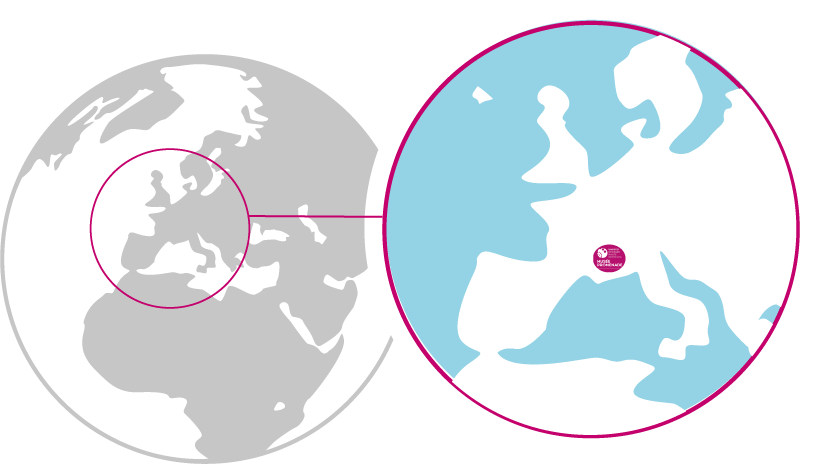A Land of many Cultures
Since the appearance of humans in the region over 400,000 years ago, humans have moved around, adapting to the geography of the area. Despite the difficult conditions, they have settled permanently in the area, occupying valleys, hills and plains.
To protect themselves, the inhabitants built villages perched on the mountain tops, like the village of Thoard. Seen from the sky, this village has a strange almond-shape that perfectly fits the landscape's natural terrain on which it is set. Elsewhere, humans have also built fortresses with great ingenuity, such as the Citadel at Sisteron or the Vauban Fort at Seyne. These ramparts against the enemy have transformed the perspective of their village.
High up or at the bottom of the valleys, the villages are the soul of this territory with their narrow streets, squares and fountains, but also their beautiful doors and majestic bell towers. Estoublon, Courbons, Prads-Haute-Bléone, are very lively villages during the of festivals of local Patron Saints, an ideal moment to sample local life and feel the Provencal way of life and way of living.
Most often, this architectural heritage draws its character from local natural resources, such as plaster (extracted from gypsum). The lime kilns and plaster mills dotted throughout the area still bear witness to the mining and processing of these local resources. Undeniably, the geological history is at the origin of these very particular soils.
The Ecomuseum (Heritage & Cultural Museum) at La Javie, retraces perfectly the daily life of the local villages at the beginning of the last century. There is a replica-reconstruction of a grocery shop, a classroom and a kitchen. This depiction of life in the past is made possible thanks to the involvement of the local inhabitants, who were eager to search for and discover in their attics all the traces of this past life.
A land of cultivation, but above all, a land of agricultural labour: fruit orchards and groves in the higher soils and valleys of Provence, fields of lavender as far as the eye can see on the plain of Valensole, fields of olive trees on the heights of Estoublon and sometimes, truffle oaks. Through the resources that humans cultivate, humans also maintain the soil. Even the shepherd who drives on foot his flocks of sheep on their annual pilgrimage to graze on the heights of alpine summer pastures effect the soil and landscape.

In the hands of our producers, local produce take on a special flavour. At Vieux Moulins, Marie-France Girard takes great care of her olive trees all year round. As soon as the first frost hits, the harvest begins! The juicy olives are then transformed into a tasty oil. Nicolosi Creation, transforms lavender, a plant with many properties, into essential-oil and cosmetic products. L'Etoile du Berger, for its part, continues the traditions of the candied-confit Sarteau pear: a pear picked in the local orchards from very old trees, so hard that it cannot be eaten without cooking it. Families have learned to cook this fruit to make jam, pear bread, fruit jelly-pastels ... and every year, the Sarteau Pear Festival in La Javie is the ideal time to taste all the interesting ways of cooking it.
VIDEO : poire Sarteau
This nourishing land also provides other raw materials for craftsmen. In Moustiers-Sainte-Marie, for example, a village nestled against the mountain and visually resembling a typical Tuscan village, one can discover the talent of Master Crafters of earthenware, pottery and ceramics, like the Bondil family. Earthenware, whose original material is none other than earthy clay, is a delicate craft that requires patience and precision. The same earthy clay, in the hands of a traditional crafter of Santons (traditional Provencal replica-figurines), is kneaded and crafted to form the Santons of Provence. With Christmas approaching, come and discover at the Santon Fair in Champtercier, these countless traditional Provencal replica-figurines represent every imaginable character and aspect of local Provencal life, both of yester-year and of today.
Many personalities have lived in the territory of the UNESCO Geopark, which has inherited the works and efforts of many lifetimes.
Alexandra David-Neel (1868-1969) is one of such interesting personalities. She was an Orientalist (an enthusiast and expert on all things orient, eastern), an Explorer and a Buddhist. She was the first European woman to visit Lhasa in Tibet in 1924. She lived the end of her life in Digne-les-Bains. Her house can be visited and exhibits of countless period photographs trace her exceptional journey.

Maria Borrély (1890-1963), was a novelist involved in the French Resistance. She is notably the author of "Le Dernier Feu" (The Last Fire) published in 1931. This novel depicts the dissertation of a local village on the vast plain of Valensole whose inhabitants, victims of the raging elements of nature, are forced to leave their land and descend into the valley.
Jean Proal (1904-1969), also a writer, was originally from the Municipal District of Seyne-les-Alpes and wrote his first novel at the age of 28: "Tempête de Printemps" (Spring Storm) published in 1932. The story takes place near Digne-les-Bains telling the story of Sylvain, 18, who decides to leave his mountain hamlet and the obligations attached to it (i.e. to take over the family farm). Through the mountains and the forests, he sets off and travels according to the seasons and the harshness of nature.
Some may be familiar with the poet and writer from Sologne, Paul Arène (1843-1896), who published his masterpiece at the age of 25, "Jean-des-Figues": the story of a young Provencal man leaving his native locality for the capital, Paris.
We can also mention Sébastien Le Prestre, Marquis de Vauban (1815-1893, a Marshal to Vauban), an engineer, a military architect, he was appointed Marshal of France by Louis XIV. He led an incredible life and was involved in the drawing of plans for the Fortification of Seyne and the Citadel at Sisteron.
As for Louis Gabriel Prosper Demontzey (1831-1898), he was an engineer for the French State Department responsible for Water & Forests, and in the 19th century he led an exceptional plan and project for the reforestation of the mountains in Alpes de Haute-Provence.






